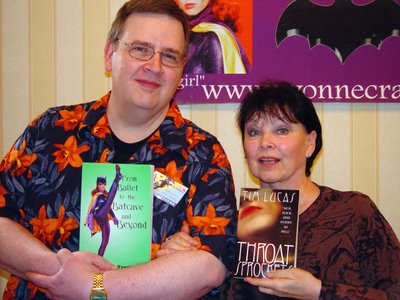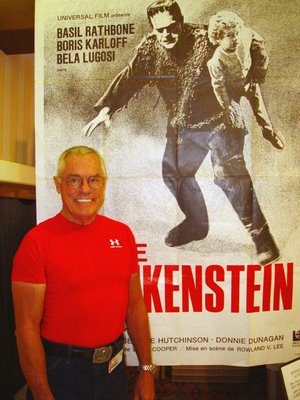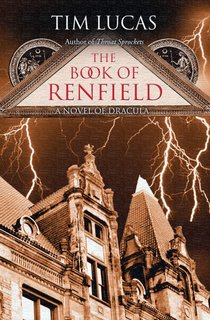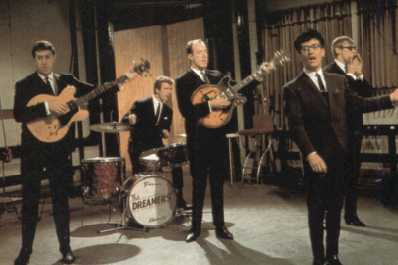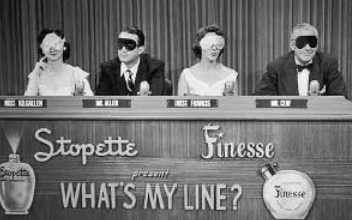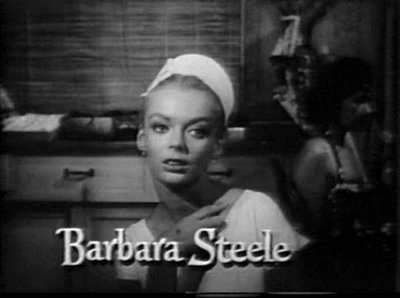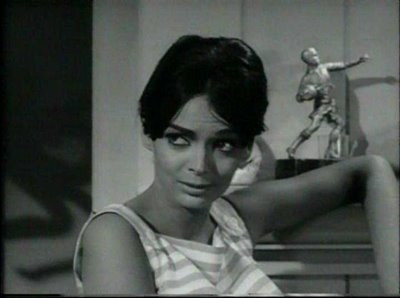 Rondo Winners of 2006: Joe Busam, Donnie Dunagan, Donna Lucas, Tom Weaver, Basil Gogos, Tim Lucas, Bob Burns, John Goodwin (accepting for Dan Roebuck) and Kathy Burns. Photo courtesy of David Phillippi.)
Rondo Winners of 2006: Joe Busam, Donnie Dunagan, Donna Lucas, Tom Weaver, Basil Gogos, Tim Lucas, Bob Burns, John Goodwin (accepting for Dan Roebuck) and Kathy Burns. Photo courtesy of David Phillippi.)  Donna and I accept our third and fourth Rondo Awards for Best Magazine. (Photo by John Clymer.)
Donna and I accept our third and fourth Rondo Awards for Best Magazine. (Photo by John Clymer.)
Taking the stage with Donna to accept our Rondo for Best Magazine (VIDEO WATCHDOG, of course) for the third and fourth years in a row, I explained that I felt a little guilty about receiving the 2005 award for producing six issues annually when we produced twice that many the previous year. As she is liable to do, Donna promptly corrected me by saying that we had actually produced eight issues last year. "Oh, then to hell with guilt!" I joked. Donna rightly pointed out that none of what we did would be possible without our wonderful contributors, and we closed by encouraging everyone to "Support Your Free Press!" (That doesn't mean "free" as in Internet, by the way. Support paper magazines if you like the idea of information sources you can trust and hold accountable -- not to mention collect!)
Donnie Dunagan and Tom Weaver accept their Rondos for Best Magazine Article of 2004 from host David Colton. (Photo by John Clymer.)
Another VW-related victory at the Rondo ceremony was the presentation of last year's Best Article award to Donnie Dunagan and interviewer Tom Weaver for "Here's To a Son of the House of Frankenstein: The Donnie Dunagan Interview," which appeared in VW #112 and was described by host Colton as one of the most remarkable documents pertinent to the genre ever published. Tom self-effacingly accorded all credit for the interview's quality to Donnie and his extraordinary life. As a very surprised Major Dunagan accepted his award and addressed the audience, he said that he recognized Rondo Hatton and had always thought of him as "the unsung hero." The Major has received many military honors in his illustrious career, but he accepted his Rondo with all the emotion and humility of someone who was, until the appearance of this interview, an unsung hero in terms of his own screen career.
 Joe Busam accepts the Rondo for Best Independent DVD as David Colton smiles approvingly. (Photo by John Clymer.)
Joe Busam accepts the Rondo for Best Independent DVD as David Colton smiles approvingly. (Photo by John Clymer.)Perhaps the biggest cheers at the Rondo Awards were reserved for Joe Busam, who accepted two awards this year -- one for his production of the PPS Group's MONSTER KID HOME MOVIES DVD (Best Independent DVD) and another naming him "Monster Kid of the Year." Joe is a fellow Cincinnatian and he told me over dinner last night that, aside from his marriage and the births of his children and the knowledge that his first grandchild is on the way, the Rondo ceremony was the greatest moment of his life. The Best Independent DVD award is now displayed in the reception area of the PPS Group offices where Joe works, and his Monster Kid of the Year award has pride of place in his own home. I've never known a more thorough and sincerely deserving Monster Kid than Joe, and it made me feel good to see his superb efforts and his sweet nature recognized and applauded.
David and Angie did a splendid job of presiding over the festivities, and special thanks to the wonderful Eileen Colton (a Woodstock veteran!) for painting the Rondo busts so beautifully.
In closing for today, there are some more things I'd like to add about Donnie Dunagan. Since posting Part 1 of this report, I remembered another topical area that the Major and I covered in our dinner conversation. We got into a discussion of the troubles being experienced by our country and how the current political system -- a polarized situation between two basically similar parties -- isn't helping. I mentioned that, in my view, the foundation of this attitude may reside in the way we're taught, from early on, "right from wrong," which leads to a simplified, either/or view of the world when many of the truths and solutions more likely reside in the gray area between. It takes more thinking to navigate that gray area, but more thoughtfulness is what this country needs. I also wish that competitive sports weren't stressed so much in schools and recreational activities; I know the theory is that it teaches kids to excel, but it also teaches kids to excel at the cost of others' excelling and fosters a liking for seeing one's competitors ground into the dirt. I'm all for sports based on individual performance, but team sports (I feel) are... if not uncivilized, at least decivilizing at heart, fostering "us versus them" thinking that we, as adults, carry over to our politics, and "scoring" attitudes that trivialize our sexual lives (and render some men deaf to the word "no"), not to mention the barbaric levels of mob violence and destructive behavior that are increasingly noticed at sports-related celebrations. I don't expect to change anybody's mind about this, but if it can happen with smoking... and I really do see this as something we need to evolve beyond before the planet can achieve true peace.

"Where's me Pot o' Gold?" Donnie Dunagan catches a pretty leprechaun at Wonderfest.
From there, we went on to discuss the media situation, which is increasingly isolating and polarizing the way Americans think. For one political party to demonize the other, we agreed, chews away like a rat at the foundation of American brotherhood. With the number of specialized cable channels available now, right-wing and left-wing thinkers have their own newscasts and need never be exposed to the other guy's way of thinking. And increasingly, Americans don't care to know what the other guy thinks. (You should read some of the mail we've received about the unavoidable political content in the LAND OF THE DEAD round table discussion in our current issue. It's like some conservatives feel that they have the right NOT to ever be exposed to contrary thinking, however reasonably expressed, and that no one with a contrary view has the right to put forth their viewpoint. And, for the record, I don't regard the most lavishly-spending, invasive US President in history as "conservative" by definition. But that's just how I and Noah Webster feel.) As Donnie told me, General George Patton attributed much of his military success to the fact that he had read the writings of Field Marshall Erwin Rommel. Yes, if you expose yourself to alternative thinking, you may run the risk of having your mind changed -- not because it will brainwash you, but because you may persuaded to genuinely see the error of your own closed-mindedness. As Donnie pointed out, for those who truly do have the conviction of their beliefs, familiarizing oneself with the way "the other side" thinks could be the key to anticipating their actions and staging their defeat. The arrogance of self-righteousness is, simply put, a weakness. Many a kingdom has fallen due to assumption and vanity. And we would never have achieved civilization if the great orators of ancient Greece hadn't conceived the symposium, giving everyone an equal voice and, more importantly, equal attention.
Donnie told me that he had read extensively the writings of America's founding fathers. I haven't, but according to him, America was initially founded on the principle that the presidency would be shared by a rotating system of five privileged families, which would have been equivalent to a domestic monarchy, if a slightly more democratic one. It was Thomas Jefferson, he told me, who proposed the party system and Benjamin Franklin who wrote that the worst thing that could ever befall this new land was to adopt a two party system; his writing specified that anything less than a five-party system was corruptible and very dangerous. He said that if I was to read Benjamin Franklin's writings on American politics with the key names and some turns of phrase blanked out, I would swear I was reading a description of our current problems.
To Be Continued.
"There's much more to say / But you must wait one day / Stay tuned to the WatchBlog Fitzgerald -- Woo HOO!"
All photos reproduced in this blog are copyrighted (c) by Tim & Donna Lucas, unless otherwise noted. All rights reserved.




